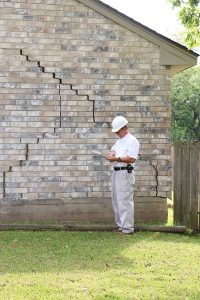Foundation Piering: What Is It And How Does It Work?
 “You have a foundation problem.” It’s a phrase that haunts homeowner’s nightmares. It sounds terrifying, and worst of all, it sounds like it’s going to be expensive to fix.
“You have a foundation problem.” It’s a phrase that haunts homeowner’s nightmares. It sounds terrifying, and worst of all, it sounds like it’s going to be expensive to fix.
Most modern homes are built on concrete foundations. Although a complete foundation replacement can be extremely expensive, there is a technique called piering that can be used to repair a sinking foundation that is comparatively cheap. In fact, it can be up to ten times cheaper than a complete foundation replacement.
So what exactly is piering? At its most basic, piering involves driving steel piles underneath a foundation to act as additional supports. Here’s how a typical piering installation works.
First, the area around the foundation is excavated to access the bottom of the foundation. The foundation is prepared so that the steel piles can be attached to the foundation with a support bracket.
Second, the steel piles are then driven into the ground until they come to a stop. Usually, this occurs when the steel piles hit compact load bearing soil, or preferably, solid rock.
Third, hydraulic jacks are used to elevate the foundation to its original height and then the steel piles are attached to the foundation using support brackets.
When the process is complete, the load of the home is transferred through the steel piles to the stable soil or rock.
There are two primary types of piers: push piers, and helical piers. Push piers are just steel piles that are drive through the ground with a hydraulic ram. Push piers, because they are designed to reach solid load bearing soils or rock, can be used to fix foundations in almost all soil conditions.
Each steel pile is individually load tested before being driven into the ground to ensure that it can sufficiently bear the final load of the home.
Helical piers involve a similar concept, but work a little differently. Helical piers are helical plates welded to bottom of steel shafts. Imagining a screw where the threads only go up one or two rotations from the bottom should give you a picture of what they look like.
Helical piers are screwed into the ground using a hydraulic torque motor and attached to the foundation in a similar manner as the push piers. However, instead of being driven to stable soil or rock, the helical plates in the soil bear the load.
Helical piers typically will bear a smaller load than push piers, but they have the advantage of being cheaper and easier to install.
